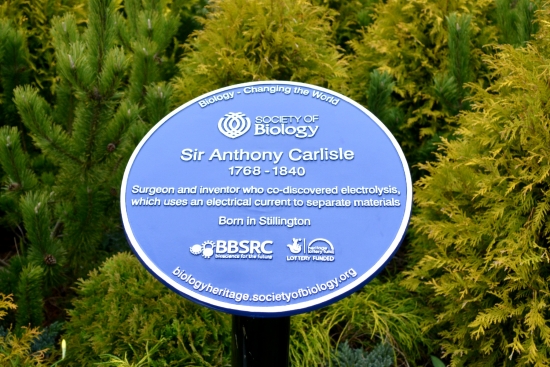News
Plaque celebrating Sir Anthony Carlisle unveiled in Stillington
- Details
- 23 March 2015
On Saturday 21st March a plaque celebrating Sir Anthony Carlisle, legendary Georgian surgeon, was unveiled in the village garden in Stillington.
Sir Anthony Carlisle (1768 – 1840) was born in Stillington and went on to become a ‘universally esteemed surgeon’. He was President of the Royal College of Surgeons and physician to the Prince Regent (later George IV) and was knighted for his services.
Sir Anthony was a man of many talents: he co-discovered electrolysis; separating water into oxygen and hydrogen for the first time, using an electric current. It is also believed he inspired Mary Shelley’s novel Frankenstein.
The Society of Biology installed the plaque as part of a new series of ten blue plaques around the UK celebrating eminent but sometimes unsung heroes of biology.
At the unveiling ceremony, Dr Richard Spencer MBE, head of science at Middlesbrough College and shortlisted candidate for Global Teacher of the Year, made a speech:
“Sir Anthony was a universally esteemed surgeon and investigative scientist. But he was also well known for his stimulating conversation. His lectures on anatomy drew huge crowds thanks to his entertaining performances.
“He studied subjects as diverse as tapeworms, disorders of old age, prevention of disease and the bones of the inner ear. However, he is best known in science for the classical experiment with Nicholson in which water was dissociated into oxygen and hydrogen for the time, using electrolysis.”
“Some evidence has recently been uncovered that Sir Anthony wrote gothic novels under the name ‘Mrs Carver’ and that he was the inspiration behind Mary Shelley's novel Frankenstein. Whether or not Sir Anthony was ‘The Real Dr Frankenstein’ is difficult to prove but I like to think so! Regardless, Sir Anthony was a truly remarkable individual and worthy of this blue plaque in commemoration of everything he achieved.”
Alex Cunningham, the MP for Stockton North, and Judith Turner, Chair of Stillington and Whitton Parish Council, also attended the celebration of this local hero.
The new series of celebratory plaques also include those to: Steptoe, Edwards and Purdy, IVF pioneers, in Oldham; Richard Owen, who invented the word ‘dinosaur’ and founded the Natural History Museum, in Lancaster; and Dolly the sheep, and the team who created her, in Edinburgh.
The ten blue plaques are part of the national Biology: Changing the World project; which also includes a new app, website, public engagement programme and teaching resources. The free app, available in the apple and android app stores, uses your location to introduce you to the great biologists who lived and worked nearby and biological discoveries which were made in the area.
Dr Mark Downs FSB, chief executive of the Society of Biology said:
“We have a great heritage of scientific discovery and an exciting future, but the biologists who have contributed to our understanding of the world are not always given the appreciation they deserve. We are delighted to be giving these biologists the recognition awarded to other great historical figures through Biology: Changing the World. The project is also a celebration of biology and biologists today. The life sciences will be essential for solving the problems of the 21st Century such as food security and antibiotic resistance. By highlighting our great biology heritage we hope to inspire the next generation.”
The Biology: Changing the World project of the Society of Biology was developed in partnership with the Biotechnology and Biological Sciences Research Council (BBSRC) and received funding from the Heritage Lottery Fund.
Professor Jackie Hunter, chief executive of the BBSRC, said:
“I’m delighted that BBSRC has been involved with this scheme to raise the profile of unsung heroes of bioscience who have changed the world with their contributions. We hope that these plaques will spark curiosity and help inspire new generations to get involved in the biosciences, which will continue to change the world and help us meet the challenges of the future.”


